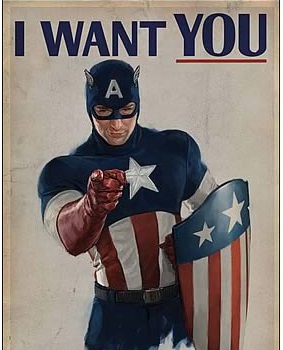On December 20, 1940, Captain America #1 went on sale, and the world learned the name Steve Rogers. The United States was nearly a year away from declaring war on Nazi Germany, but famously, Steve Rogers debuted with a right hook to Hitler’s jaw.

Despite the star-spangled costume and the hyper-patriotic code name, Steve never falls into the traps of American jingoism. He resiliently stands for the better angels of our nature, and for the highest ideals of the American experiment.
Last Friday night, a terrible crime was committed in Paris. As frightened citizens and visitors sought shelter, Parisians responded with the social media hashtag #PorteOuverte—open door—offering their homes to anyone who needed to get off the streets during that dark night. But an ocean away, twenty-six American governors gave in to the opposite urge, closing their doors to refugees fleeing the same evil.
In this world, in this America, Steve Rogers will return to theaters with Captain America: Civil War—standing tall as a frightened world demands registration and monitoring of super heroes. And as cowardice and bigotry threaten fundamental American values, it’s time again to turn to the Star-Spangled Man.
Steve was born to Sarah and Joseph Rogers, both Irish immigrants, on the Fourth of July, 1920. A century ago, Ireland resembled modern Syria more than the bucolic Emerald Isle of today. Sharply divided on sectarian lines, the Protestant minority dominated the Catholic majority, to great resentment. Hundreds died as the British army cracked down on protesters, and the rebels armed themselves and took to the streets. By the time of Rogers’ birth, Ireland was convulsed by war.
Irish civilians who fled to the United States received a chilly reception. Their Catholic faith was foreign, and drew attacks from the Ku Klux Klan. Further, the Irish were perceived as dangerous, and potential saboteurs. Outmatched by the British forces, the Irish rebels fought with assassinations and guerrilla warfare—terrorism, in short. Many immigrants had Marxist leanings, tapping into American fears of a global Communist conspiracy. But despite the paranoia, there was never a threat to the United States.
But still, Steve’s parents made it to America, and Steve, the son of migrants and refugees, was born in New York City. And Steve believed that that meant something.
Grown up, Steve stands for the best version of America. Even when there’s a cost. Even when there’s risk. When the Nazis threatened the world, young Steve desperately sought to enlist, lying about his name, his age, his health, and anything else that might hold him out of the service. Significant personal risk faded in importance when Hitler’s rise demanded action.
 The super-soldier serum was dangerous, experimental, and painful. But Steve took it anyway, accepting the personal sacrifice because the world needed a hero. No matter what, Steve stood up for what was right. He was willing to put others before himself and unflinchingly defended the vulnerable in their greatest time of need.
The super-soldier serum was dangerous, experimental, and painful. But Steve took it anyway, accepting the personal sacrifice because the world needed a hero. No matter what, Steve stood up for what was right. He was willing to put others before himself and unflinchingly defended the vulnerable in their greatest time of need.

This ethos isn’t uniquely American, but seeing that image projected up in red, white, and blue means something. Steve Rogers is the icon of a country that pronounces itself the land of the free and the home of the brave before it can begin a baseball game. A country teeming with people of all kinds living in harmony and peace, where doors were open to anyone with the will and the heart to get here. A country whose harbor is guarded by a colossus who lifts her lamp to welcome the huddled masses through a golden door.
But of course, our better angels have not always prevailed. This is a country whose independence was declared by a slaver, which massacred the first nations to call it home, which turned a ship of Jewish refugees back to the Third Reich. We are still the country that turned to HYDRA when Steve was gone.
In the past week, it has become clear that America once again stands at a crossroads. Refugees from Syria, fleeing the barbarity of Daesh and Assad, seek refuge here, and ask for asylum in our city on a hill. Using fear to mask their bigotry, many Americans have turned their backs. Others have turned to terrorism—the weapon of Daesh—to drive out those with no greater wish than to call this land their home.
It is a test. Again, we are asked to decide whether or not a nation conceived in liberty and dedicated to the proposition that all men are created equal can long endure. With the torch passed to a new generation of Americans, are we unwilling to witness or permit the slow undoing of those human rights to which this nation has always been committed, and to which we are committed today at home and around the world? Are we still a beacon, still a magnet for all who must have freedom, for all the pilgrims from all the lost places who are hurtling through the darkness, toward home?
In the comics, Steve himself has passed the shield to a new generation, to Sam Wilson, who has already taken on the burden of defending that vision of an America which stands for something, an America which welcomes those in their greatest hour of need, and which doesn’t cower behind its own paranoia and prejudice.
As the men who stand for the presidency of the United States demand registration and monitoring for the victims of their own paranoia, or seek to impose a religious test on those seeking our protection, and who push for renewed violence to befall those who have already suffered too much…
What would Steve Rogers do?

Follow Lady Geek Girl and Friends on Twitter, Tumblr, and Facebook!



Love, love, love this post.